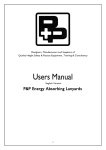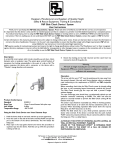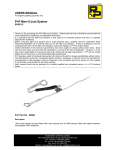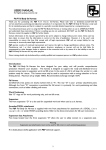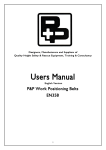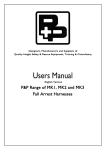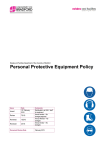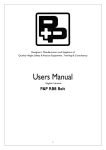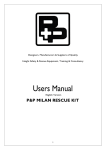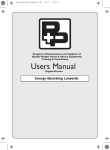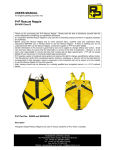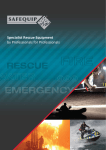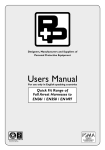Download Users Manual P&P Energy Absorbing Lanyards
Transcript
Designers, Manufacturers and Suppliers of Quality Height Safety & Rescue Equipment, Training & Consultancy Users Manual English Version P&P Energy Absorbing Lanyards 1 Thank you for purchasing this Lanyard. Please take time to familiarize yourself with the correct use and operation. It is imperative that this Lanyard is only used for its intended purpose and that it is subject to a periodic recorded detailed inspection by a competent person. To avoid personal injury, prior to using this Lanyard or training others to use it, CAREFULLY READ and understand these instructions. If there is anything you do not understand DO NOT use the Lanyard, contact the supplier or P&P for further details. Certain information in this manual is governed by law and is subject to change without prior notice. Great care has been taken to ensure that the information is correct at the time of publication. However, it is the user’s sole responsibility to ensure that they fully comply with all legal requirements. P&P will not accept liability for any inaccuracy or incorrectly stated legal requirements. P&P operate a policy of continual improvement and reserve the right to change specifications without notice. The Manufacturer and / or their recognised agents, directors, employees or insurers will not be held liable for consequential or other damages, losses or expenses in the connection with or by reason of or the inability to use the Lanyard for any other purpose. Note; training should only be delivered by a suitably qualified and competent person, i.e. a P&P products trainer. Description All of the following Lanyards are made incorporating an energy absorbing pack. They are all Fall Arrest Lanyards to BS EN 355 for arresting a potential fall, and are designed for use as part of a fall arrest system comprising a Lanyard and compatible BS EN 361 harness. P&P manufacture a standard range of Lanyards fitted with connectors and links to meet most user requirements. When required users may specify Lanyards with different connector/link configurations - in this case all connectors will comply with BS EN 362 and links will be CE marked. Contact your supplier or P&P if you require further information. DO NOT use this Lanyard until you have read and fully understood these instructions. IF IN DOUBT, CHECK BACK WITH THE SUPPLIER OR P&P. Important DO NOT • Do not anchor to a structure that itself can fall i.e. freestanding ladder or any loose structure. • Do not use an anchorage point that will not take a shock load of 10kN. • Do not use an anchorage point that is located below the point of attachment to your harness, unless you have no other choice. • Do not tie a knot in a lanyard to make it shorter, it can reduce the lanyard strength by 50% • Do not use waist connection points on a harness for Fall Arrest. Waist connection points are for work positioning or restraint only. • Do not loop standard Lanyards around obstructions with sharp edges. If a Lanyard is to be looped around a structure (choked), a protection sleeve should be fitted. • Do not extend the length of your Lanyard. Before Using P&P recommend that users are trained in the proper use and practical/physical limitations of this Lanyard. Equipment specifiers / users must ensure this device is used with compatible equipment and connectors. Failure to ensure compatibility may result in an unsafe condition or even connector/link failure. It is strongly recommended that users are trained in its proper use and practical/physical limitations. Warning All work at height including the use of Personal Protective Equipment (PPE) as a control measure is subject to a suitable and sufficient risk assessment. IF IN DOUBT, CONTACT YOUR SUPPLIER OR P&P FOR ADVICE. Usage Prior to use, a full visual inspection of every part of the fall arrest system must be carried out by the user as detailed in this P&P user manual. This item of fall arrest system is for personal use only. Only use EN362 connectors (hooks, karabiners etc.) approved and recommended by P&P. Check the inspection record for this Lanyard to ensure that regular inspections have been correctly recorded. It is strongly recommended that the user is given adequate practical training prior to using this Lanyard or any other P&P product. DO • • 2 Connect the energy absorber end of the Lanyard to the harness and the free end to the fall arrest anchorage point. Ensure that this Lanyard is connected to the correct fall arrest attachment point of an EN361 full body harness (either front sternum point or rear dorsal ‘D’ ring), usually marked by a letter ‘A’.* • • • • connection between the energy absorber and 'tails' of the Lanyard. Alternatively, a sacrificial point such as a P&P breakaway parking point may be used to 'park up' / 'stow' an un-used Lanyard tail. Should you require further information or an explanation of this potential problem please do not hesitate to contact the supplier or P&P for further detail? Use approved permanent anchorage points that have been built or installed by approved installers. Ensure that the karabiner, scaffold hook or snap hook is correctly loaded. A connector must only be attached to a compatible anchorage point or harness fall arrest point that loads the Lanyard connector along its major axis. There must be no tendency for the Lanyard connector to twist or trap in such a way that an arrest force will be applied across its gate. Ensure that the closing mechanism on the connector is locked shut. ‘Kwiklok’, ‘Locksafe’ and ‘Double Action’ hook types do this automatically, but should still be checked. ‘Screwgate’ types must be screwed home manually and checked by applying pressure against the closing mechanism. Ensure the connector, karabiner or snap-hook is loaded along its major axis. Be aware of ‘cross gate loading’. A karabiner is engineered to ‘direct’ force along its major axis – but still check! Minimum Free Space (MFS) Fall arrest systems are designed to arrest a person's fall in as short a distance as possible and limit the arrest force to below 6kN. This is achieved by absorbing the energy generated in the fall by applying an arresting force to the user over a distance, i.e. the ‘arrest distance’. In order to prevent the possibility of a collision, there must be sufficient free space directly under the user for the fall to be arrested in, i.e. the free space must be greater than the arrest distance. Free space means that the path of the fall is free from obstacles. MFS is defined as the vertical distance measured from the anchorage, (where the Lanyard attaches to the structure), to the ground level, the next lower substantive platform, or the nearest significant obstacle, depending upon the application. Application of the MFS ensures the safe arrest of a faller and avoids the possibility of a collision. When using the P&P ‘Chunkie’ Energy Absorber Lanyard with a Fall Arrest Safety Harness, the MFS is determined by adding together the original length of the Lanyard, the potential deployment of the energy absorber Lanyard, the height of the user (normally taken as 2m, due to harness stretch and feet hanging down) and safety clearance of at least 0.5m. The maximum deployment length of a ‘Chunkie’ Energy Absorber is 1.5m. The actual deployment length depends upon freefall distance before initial arrest and mass of the user. Below is a table showing deployment lengths based on a 2m version of the Lanyard with a 100 kg mass. Deployment lengths of 2 metre P&P Energy Absorbing Lanyard using a 100Kg solid rigid test mass. The data is based on the P&P Energy Absorbing Lanyard being used in 3 different Fall Factors (FF) - FF 0.5 (1m free fall), FF 1 (2m free fall) and FF 2 (4m free fall). Connector Loading 3 2 • Correct loading with gate mechanism secured shut. Incorrect loading. Ensure that your anchorage is located directly above the working position and that you have sufficient free space with no hazards or protrusions beneath you. SEE MINIMUM FREE SPACE SECTION. P&P TWIN TAILS WARNING NOTICE In common with all 'Two Tails' / 'Twin Tailed' Lanyards Users must be aware of the following. If one of the tails is not in use the un-used tail MUST NOT BE 'parked up' / 'stowed' by being attached to the primary strap of the User's harness or anyone of the attachment 'D' rings of the harness. This is due to the fact that should a fall occur and be arrested by the other tail, the attached 'parked up' / 'stowed' Lanyard may prevent the energy absorber from deploying fully and hence subject the user to a greater arrest force than permitted by the European Fall Protection standard. P&P would therefore strongly recommend the user keeps both tails attached to the structure at all times or parks the un-used tail of the Lanyard onto the welded ring or 'D' ring that makes the LANYARD 2.0m Chunkie FF 0.5 1m Free Fall FF 1 2m Free Fall FF 2 4m Free Fall 0.4m 0.8m 1.5m These figures are specific to the P&P range of products – it should be noted that other manufacturers’ energy absorbers may deploy up to 1.75m. 3 Explanation of Fall Factors Fall Factor 0.5 - FF 0.5 means that the Lanyard would be connected above the user and you would fall half the length of the Lanyard before arrest. Fall Factor 1 - FF 1 means that the Lanyard would be connected around chest height of the user and you would fall the length of the Lanyard before arrest. Fall Factor 2 - FF2 means that the Lanyard would be connected below the user and you would fall twice the length of the Lanyard before arrest. The following pictograms illustrate the calculations needed to be done before using an Energy Absorbing Lanyard. 'C' always equals a minimum safety clearance of 0.5m, ‘B' always equals height of user, normally taken at 2m, 'A’ is the variable specific to your application depending upon original Lanyard length and fall factor situation you are working in. Example 3 2m Free Fall - using a 2m energy absorbing Lanyard in a fall factor 1 situation ie. clipped at the same height as your chest. Example 1 4m Free Fall - using a 2m Energy Absorbing Lanyard in a fall factor 2 situation ie. clipped below your feet. As all testing of energy absorbing Lanyards is based on a 100kg mass, we offer the following guidance for users over 100kg. The data is based on the P&P Energy Absorbing Lanyard being used in a potential fall factor 2 situation (clipped to a suitable solid rigid anchor below the user's feet - not recommended!) Example 2 1m Free Fall - using a 2m energy absorbing Lanyard in a fall factor 0.5 situation ie. clipped above your head. CHUNKIE 2.0m 1.75m 1.50m 1.25m 1.00m 4 60kg 100kg 120kg 130kg 140kg 3 3 3 3 3 3 3 3 3 3 ? 3 3 3 3 2 2 2 2 2 ? 3 3 ? 3 Key: 3 Arrest Force below 6kN as required by European Fall Protection Standards. ? If used in a fall factor 2 situation the arrest forces will exceed 6kN but NOT be above 8kN - not ideal but certainly considered survivable. 2 Do Not Use in fall factor 2 situations arrest forces will exceed 8kN. Based on the above information what can be concluded is that a P&P ‘Chunkie’, at any length, if only used in a fall factor 1 situation (clipped to a suitable anchor at chest height, so the fall distance does not and can not exceed 2m) will limit the arrest force acting on a User weighing up to 140Kg to less than 6kN. legible on the Product Label or do not match the User Manual - DO NOT USE the Lanyard! The Lanyard, along with all your other safety equipment must be subjected to a pre-use check each time before use. Failure to inspect the Lanyard correctly could cost you your life. You should be trained to carry out a preuse check. Detailed Recorded Inspections should only be carried out by a competent person, appointed by the employer. Additionally, recorded interim inspections may be required where risks from transient arduous working environments exist. This should be identified through Risk Assessment. These recorded inspections must be carried out at least every 12 months as a requirement of EN365, however; in the UK the HSE would like to see all Fall Protection PPE have a Detailed Recorded Inspection every 6 months. The pre-use check must include (but is not limited to): • Check all webbing / rope for signs of cuts, abrasions, fraying, tears, burns, mould, discolouration or chemical attack. • Check all stitching for signs of loosening, pulling or cut thread. There must be no evidence of damaged stitching on either side of the stitch pattern. • Check the Energy Absorber Pack for signs of exposed ‘tear webbing’ visible at the ends. Exposure of ‘tear webbing’ indicates the Lanyard may have been subject to a fall. • Check all shrink sleeving is intact and protecting rope or webbing. • If the Lanyard has been subject to significant paint overspray, it must not be used. • Adjusters and connectors MUST be free from rust, excessive wear, distortion or cracks. • All connectors/links must operate correctly with no tendency for gates to stick or jam. ? If during the pre-use check any part is found to be or believed to be faulty DO NOT use it. Remove ALL components from site to ensure that they cannot be used by anyone. Modifications and Repairs No repairs, modifications or alterations are to be carried out on this Lanyard. Marking of PPE Textile products including webbing and rope must not be marked using ink or paint. Marker pens and paint will contaminate textile fibres leading to potential damage from material stiffening or even chemical attack. Plastic or Metal casings of components must not be marked by stamping, etching or engraving. These processes may weaken the material or damage protective coatings. P&P advise that if additional identification is required a tagging system (label or electronic) should be used that does not interfere in any way with the operation of equipment or devices. Contact P&P or your supplier for advice on additional labelling. Rescue Plan Rescue Plan As part of your risk assessment you MUST have in place a rescue plan to deal with any emergency, which may occur during use. Access to the user, directly or indirectly and their safe retrieval is of paramount importance, including preparations for dealing with potential Post Fall Suspension Syncope Inspection Cleaning, Maintenance and Storage This manual contains a Declaration of conformity and a section for recording your periodic 'Detailed Inspections'. On the back page of this manual is a space for the user to record the product name, unique serial number and date of manufacture. The product name, unique serial number and date of manufacture will be found on the product label either stitched into the Lanyard's webbing or captive at the end of the rope. Always make sure the product label is present showing both the serial number and date of manufacture and that it matches your User Manual. If the numbers are not Keep the Lanyard clean and dry. Remove excess moisture with a clean cloth then allow drying naturally in a warm room away from direct heat. You may clean this lanyard using water but avoid getting soap/detergent into buckles. First rinse in clean cold water – if still soiled; wash in clean warm water (40ºC max) using a mild detergent if necessary. Thoroughly rinse in clean cold water and dry as described above. Chemical Attack Avoid contact with any chemical, which might affect the performance of this lanyard, e.g these include all acids 5 and strong caustic substances (vehicle battery acid, bleach etc) If subject to chemical attack, you must remove it from service and check with the supplier or P&P for advice on the possible consequence of chemical degradation. years from the recorded date of first use, provided the item has been correctly stored, maintained subjected to regular inspections by a trained competent person. However, if the item fails inspection it MUST be destroyed. Storage After any necessary cleaning, dry completely then store in a cool dry place, which will protect it from extreme humidity and direct heat. A new item of Fall Protection Equipment manufactured by P&P Limited may be stored for a maximum of 3 years and will still give the potential 5 year working life provided it remains in the original manufacturer's packaging. Once the product is taken from this original packaging for the first time, this date becomes the “date of first use", which should be recorded on the Inspection Record and the 5 year working life begins. Transportation Care should be taken to protect the lanyard against risks such as those detailed under Service Life. A simple effective way is to transport the lanyard in a suitable bag or container, which prevents abrasion. that and and any Reference should also be made to the British Standard BS 8473:2005 - "The code of practice selection, use and maintenance of personal fall protection systems and equipment for use in the workplace" - clause 13.2 Lifespan, which states: Service Life The Lanyard has a maximum working life of 5 years from date of first use, provided it is correctly stored and maintained. However, if the lanyard fails any inspection it MUST be destroyed. See the Statement of Obsolescence within this manual. "Some equipment is given a life span or obsolescence date by the manufacturer. Equipment that has reached such a limit, which has not already been rejected for other reasons, should be withdrawn from service and not used again, unless or until confirmed by a competent person, in writing, that it is acceptable to do so." About This Manual This User Manual is for English speaking countries only. If you require this manual in a different language, please Contact P&P. When this item is sold on, this manual must accompany it and be supplied in the language of the destination country. It should be noted that inspections carried out by a trained and competent person are only visual and tactile observations of the condition of the product; they are not testing the residual strength of the equipment. All synthetic fibres deteriorate slowly with age regardless of use and as a result, P&P Limited strongly advises all users of Fall Protection Equipment to follow the manufacturer's statement of obsolescence. Product Details The Product Code, Serial number and Date of Manufacture of the Lanyard should be entered on the back page of this manual for future reference and inspection purposes. For further advice on this statement, as well as training in the use and inspection of Fall Protection Equipment, please contact P&P Limited. Warning This Lanyard must be used by persons who are medically fit to do so. If you have any medical condition, are recovering from any medical condition or suffer from any physical or mental disability you must seek professional medical advice before using this Lanyard. Statement of Obsolescence Due to the ingress of dirt and grit, chemical contamination, edge and surface damage, ultraviolet light degradation, and wear and tear, Fall Protection Equipment manufactured from synthetic fibres (webbing and/or rope) is subject to a manufacturer’s statement of obsolescence, which is a requirement of BS EN 365:2004 a European Product Standard. Any item of Fall Protection Equipment manufactured by P&P Limited with synthetic fibre components (webbing and/or rope) is subject to a maximum working life of 5 6 7 Designers, Manufacturers and Suppliers of Quality Height Safety & Rescue Equipment, Training & Consultancy EC DECLARATION OF CONFORMITY The Manufacturer in the Community P&P Limited, 131 New John Street, Aston, Birmingham B6 4LD United Kingdom Declares that the PPE described hereafter as the Energy Absorbing Lanyards is in conformity with the provisions of Council Directive 89/686/EEC and where such is the case, with the national standard transposing harmonizing standard numbers: BSEN 355:2002 is identical to the PPE which is subject to EC certificate of conformity number BSEN 355/04/013 dated 15/10/2004 amended by certificate AD134 dated 10/06/2010 issued by TUV NEL Limited, East Kilbride, Glasgow, G75 0QU, United Kingdom EC Notified Body No 0320 is subject to the procedures set out in Article 11 point B of Directive 89/686/EEC under the supervision of the approved body: The British Standards Institute, 389 Chiswick High Road, London W4 4AL, United Kingdom EC Notified Body No 0086 Done at Birmingham, United Kingdom on 6 June 2011 H&S/Technical Manager PRODUCT NAME:……………………………….. PRODUCT CODE:………………………………... SERIAL NUMBER:……………………………….. DATE OF MANUFACTURE:……………………. P&P Limited, 131 New John Street, Aston, Birmingham B6 4LD, England. Telephone: 0121 359 4561 Facsimile: 0121 359 4136 Email: [email protected] Website: www.ppsafety.co.uk This Manual and its contents © P&P Limited 2011 Energy Absorbing Lanyards V 3_0611 All rights reserved. No part of this publication may be reproduced, stored in a retrieval system, or transmitted, in any form or by any means, electronic, mechanical, photocopying, recording or otherwise, without the prior permission of P&P Limited. P&P Limited, 131 New John Street, Aston, Birmingham B6 4LD, England. Tel: +44 (0)121 359 4561 Facsimile: +44 (0)121 359 4136 e-mail: [email protected] website: www.ppsafety.co.uk Registered in England No. 1493537 8








